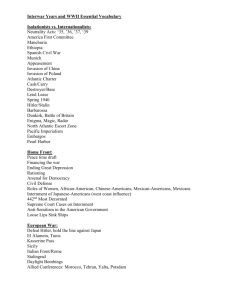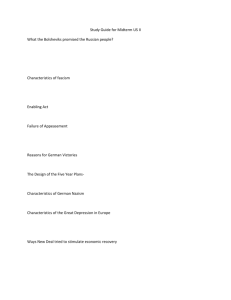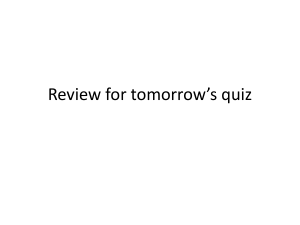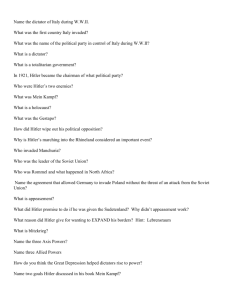Review Guide
advertisement
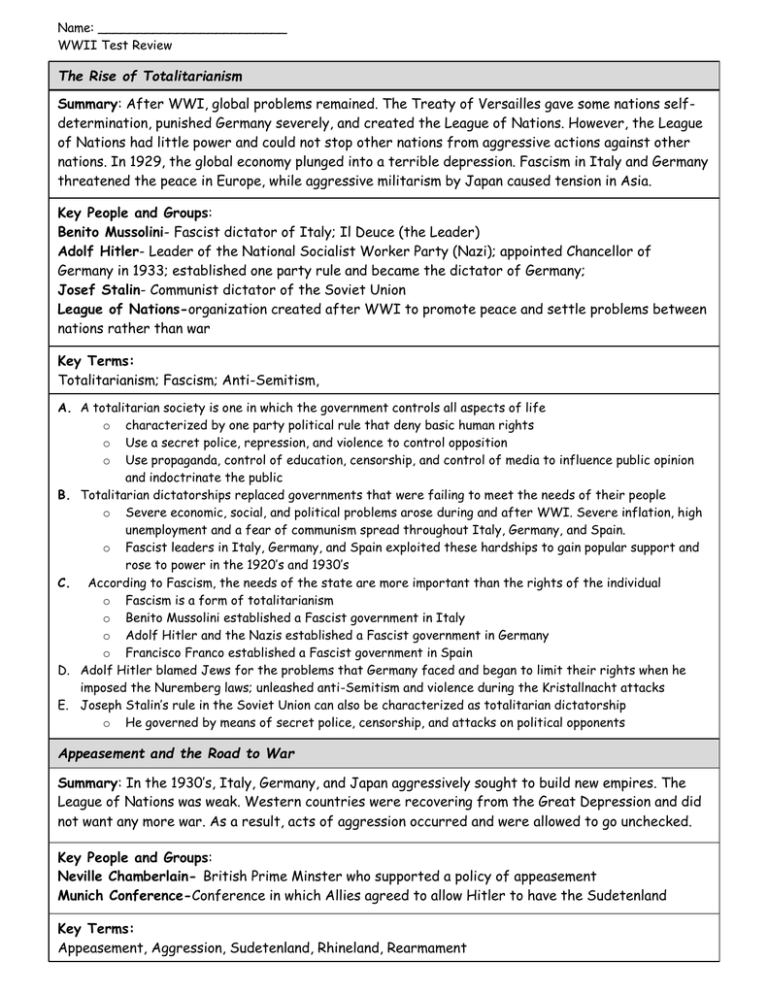
Name: ________________________ WWII Test Review The Rise of Totalitarianism Summary: After WWI, global problems remained. The Treaty of Versailles gave some nations selfdetermination, punished Germany severely, and created the League of Nations. However, the League of Nations had little power and could not stop other nations from aggressive actions against other nations. In 1929, the global economy plunged into a terrible depression. Fascism in Italy and Germany threatened the peace in Europe, while aggressive militarism by Japan caused tension in Asia. Key People and Groups: Benito Mussolini- Fascist dictator of Italy; Il Deuce (the Leader) Adolf Hitler- Leader of the National Socialist Worker Party (Nazi); appointed Chancellor of Germany in 1933; established one party rule and became the dictator of Germany; Josef Stalin- Communist dictator of the Soviet Union League of Nations-organization created after WWI to promote peace and settle problems between nations rather than war Key Terms: Totalitarianism; Fascism; Anti-Semitism, A. A totalitarian society is one in which the government controls all aspects of life o characterized by one party political rule that deny basic human rights o Use a secret police, repression, and violence to control opposition o Use propaganda, control of education, censorship, and control of media to influence public opinion and indoctrinate the public B. Totalitarian dictatorships replaced governments that were failing to meet the needs of their people o Severe economic, social, and political problems arose during and after WWI. Severe inflation, high unemployment and a fear of communism spread throughout Italy, Germany, and Spain. o Fascist leaders in Italy, Germany, and Spain exploited these hardships to gain popular support and rose to power in the 1920’s and 1930’s C. According to Fascism, the needs of the state are more important than the rights of the individual o Fascism is a form of totalitarianism o Benito Mussolini established a Fascist government in Italy o Adolf Hitler and the Nazis established a Fascist government in Germany o Francisco Franco established a Fascist government in Spain D. Adolf Hitler blamed Jews for the problems that Germany faced and began to limit their rights when he imposed the Nuremberg laws; unleashed anti-Semitism and violence during the Kristallnacht attacks E. Joseph Stalin’s rule in the Soviet Union can also be characterized as totalitarian dictatorship o He governed by means of secret police, censorship, and attacks on political opponents Appeasement and the Road to War Summary: In the 1930’s, Italy, Germany, and Japan aggressively sought to build new empires. The League of Nations was weak. Western countries were recovering from the Great Depression and did not want any more war. As a result, acts of aggression occurred and were allowed to go unchecked. Key People and Groups: Neville Chamberlain- British Prime Minster who supported a policy of appeasement Munich Conference-Conference in which Allies agreed to allow Hitler to have the Sudetenland Key Terms: Appeasement, Aggression, Sudetenland, Rhineland, Rearmament A. The Japanese pursued a policy of expansionism before WWI to gain natural resources o Invaded Manchuria (1931) o Invaded all of China (1937) B. Italy under the rule of Mussolini invaded Ethiopia in 1935 C. Hitler began an aggressive policy to reverse the harsh effects of the Treaty of Versailles on Germany o Begins the rearmament of Germany (1933) o Moves troops into the Rhineland in 1936 o Announces union with Austria in 1938 o Takes the Sudetenland in 1938 o Invades all of Czechoslovakia in 1939 D. The weakness of the League of Nations prevented it from stopping Japan, Germany, and Italy’s aggressive actions during the 1930’s E. Germany, Italy, and Japan formed an alliance known as the Axis Powers F. Germany signed a non aggression pact with the Soviet Union before launching the invasion of Poland G. Some European leaders agreed to Hitler’s demands concerning Czechoslovakia in 1938, they were supporting a policy of appeasement o Appeasement is an attempt to avoid conflict by meeting the demands of an aggressor o One reason that Britain, France, and Italy agreed to appease Hitler at the Munich conference was to avoid another world war. o The policy of appeasement helped cause WWII because this policy allowed aggressive actions of Germany to go unchecked F. The United States responded to Japanese aggression in Asia by placing economic embargo on Japan o Did not sell oil, steel, scrap metal to Japan World War II Summary: When Germany invaded Poland in 1939, World War II began, and the world faced the most devastating conflict in human history. During WWII, new weapons with massive power caused the loss of millions of lives. Civilians were greatly affected by the war, facing rationing, military attacks, and sometimes limits on their rights. At first, the Axis powers won major victories. After the entry of the United States and the Soviet Union on the Allied side, however the tide began to turn in favor of the Allies. The Battle of Stalingrad and the invasion of Normandy were turning point battles in the European theater. The Battle of Midway turned the war in favor the United States in the Pacific. The war finally ended in 1945. The war finally ended in 1945. World War II resulted in millions of deaths, heavy economic losses, and brutality on a scale such as the world had not seen before. Key People and Groups: Winston Churchill- British Prime Minster during WWII Franklin D. Roosevelt-President of the United States during WWII Emperor Hirohito-Japanese emperor during WWII; was more of figurehead since the military held the real power in Japan during the 1930’s Key Terms: Blitzkrieg, Battle of Britain, Stalingrad, Normandy, D-Day, Midway, total war, Manhattan Project, Island hopping, turning points, Holocaust, Nuremberg trials, war crimes, genocide, Pearl Harbor A. World War II began after the German invasion of Poland on September 1, 1939 B. Germany was able to rapidly conquer territory using Blitzkrieg tactics o Poland, Norway, Denmark, Holland, Belgium, France o Joined with Italy to take control of the Balkans and North Africa C. Hitler failed to destroy the British Royal Air Force during the Battle of Britain o Wanted to destroy British air power before launching an invasion of Britain o German Luftwaffe suffered heavy losses o New invention of radar allowed British pilots to prepare for German air attacks D. The Japanese attack on Pearl Harbor on Dec. 7, 1941 pulled the United States into the war E. Hitler invaded the Soviet Union during Operation Barbarossa o Large size of Russia and rapid advance caused the Germans to overstretch their supply lines o Cold weather, harsh winters made fighting in Russia very difficult for the Germans o German defeat at the Battle of Stalingrad was a turning point in the eastern part of the European theater F. The United States and Britain opened up a second front in Europe during the Normandy invasion on D-Day o This forced the Germans to fight a two front war G. Faced with American and British forces invading Germany from the West and Soviet forces invading from the East, Germany surrendered in May 1945 f. American forces used the island hopping strategy to take strategic islands from the Japanese in the Pacific theater o Battles in the Pacific theater were very bloody and both sides took many causalities since the Japanese often would not surrender when faced with defeat o United States eventually gained islands to create air fields that placed American bombers in range of Japanese cities G. The dropping of the atomic bombs on Hiroshima and Nagasaki led the Japanese Emperor Hirohito to surrender on August 15, 1945; Japan signed surrender on Sept 2, 1945 F. As Allied armies moved across Europe, they liberated Jews and other groups that were deemed inferior by the Nazis from concentration camps. o The Holocaust that resulted from Hitler’s “final solution” resulted in the mass murder of 6 million Jews in Europe o Nazi officials were placed on trial for crimes against humanity and war crimes during the Nuremberg trials o The Holocaust is an example of genocide G. Japanese officials were placed on trial in Tokyo for war crimes and atrocities committed in places like Nanking and for their mistreatment of prisoners of war. H. New weapons, particularly air power, resulted in the deaths of over 60 million people during the war o Many of the deaths in WWII were civilians o Nations felt justified attacking civilians because of total war



